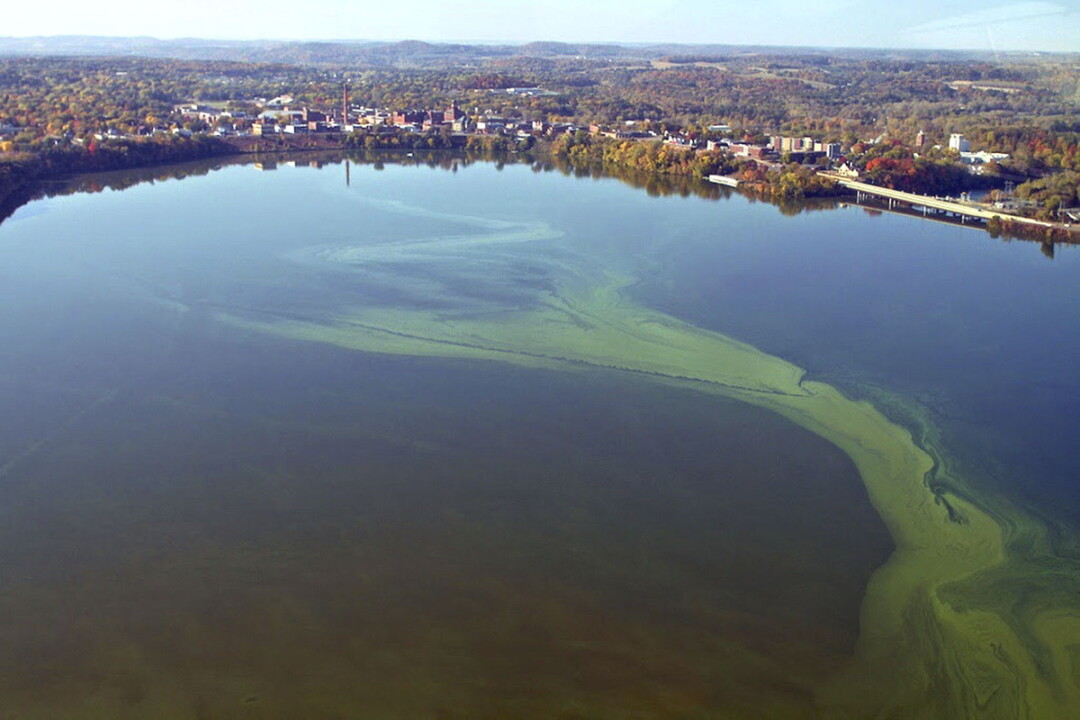Red Cedar Watershed Gets the Blues
program explores social aspects of reducing blue-green algae woes

Local and regional partners in a new collaborative effort led by UW-Stout, the state Department of Natural Resources, and the U.S. Army Corps of Engineers are ready to harness their resources to improve water quality in the Red Cedar River watershed.
The DNR recently awarded a $200,000 lake protection grant to the project, and the Army Corps has committed $300,000 in water quality assessment funding from 2016 through 2018 to identify solutions and implement them to help reduce toxic blue-green algae blooms in the nearly 1,900-square mile watershed across 10 west-central Wisconsin counties.
The project, called the Red Cedar River Water Quality Partnership, includes other government agencies and organizations that have been working on the problem for more than 25 years.
The impact of the toxic algae blooms that turn the water green stretches from lakes Tainter and Menomin in Menomonie to the Chetek chain of lakes in Barron County and to the headwaters of the Red Cedar River on Big Chetac Lake near Birchwood.
The significance of the new effort is threefold: The sizable amount of funding, the sheer number of groups on board, and the decision to include social impact as part of the research process to identify solutions.
Nels Paulson, an associate professor of sociology at UW-Stout, has co-led three summers of undergraduate research through the separately funded LAKES REU (which stands for “Research Experience for Undergraduates”). He said the most significant aspect of RCRWQP is likely the expanded social science research.
LAKES students have documented how poor water quality affects recreation, tourism, real estate and, therefore, the economy and quality of life in the impacted areas. LAKES already has shown that improved water quality would boost the Menomonie area economy by $36.6 million a year (at that’s a conservative estimate). The new funding will help complete a full social science analysis of the problem.
“The DNR and Army Corps have been wanting to integrate more social science into water quality research projects. With this knowledge, we can help empower the community to clean up the watershed,” Paulson said.
“When organizations get together, that’s how you get more research done. We’re expanding on the research efforts we’re doing and want to be a pilot for how to do this across the state in the future. I’ve been told that nothing like this has ever been done before,” he added.
Patrick “Buzz” Sorge, lake grants coordinator for the DNR’s west-central region, agrees. “I’m extremely excited about this and the potential outcome,” he said.
Sorge credits LAKES for revealing the scope of the problem beyond its root cause, which is excessive phosphorous in the watershed’s streams, rivers, and lakes.
“The biophysical chemistry is the ‘what’ so to speak. We’ve got a lot of ‘what’ out there. The social science will be the ‘how do we get this done,’ and the ‘how’ is really important,” Sorge said. “It was really the LAKES REU students who gave us these insights.
“We’ve got to change the paradigm to solve these water quality problems. By allowing all this to happen in one major project is outstanding, and to have one of our state university institutions practice the Wisconsin Idea also is very rewarding,” he added.
The purpose of the social science assessment is to identify the major attitudinal, normative, economic, and cultural factors that shape land-use decisions and community incentives and policies, according to Paulson and Sorge. “By distinguishing such variables the local townships, cities, and counties can move forward with ways to grow their community capacity for changing land-use norms and practices and improve water resources and quality of life in the Red Cedar basin,” Paulson said.
Paulson, Sorge, and the Army Corps don’t expect the decades-old water quality problems to magically be solved in the next three years, but RCRWQP can build the foundation for change in the near future.
“This is foundational work that hopefully will allow the rest of the work to move forward at a quicker and more appropriate scale. This doesn’t work if we get 30 to 50 percent of pollution sources under control. We need to be 70 to 90 percent. Then you’ll see lakes Tainter and Menomin look much different in August,” Sorge said.
RCRWQP will get underway this summer through more LAKES research and with the hiring of a research coordinator.
The Army Corps’ $300,000 commitment will provide modeling and water quality monitoring tools and some staff support for the project, said Nate Campbell, a biologist and project manager for the Army Corps’ St. Paul district. The Army Corps will work directly with UW-Stout biology instructor Bill James, a former Army Corps employee, and other professors.
The hard science of water testing needs to tie in with social science research “to really get things done in a watershed,” Campbell said.
“We’re really excited to be involved. It’s rare to see so many groups working together. With UW-Stout’s work in outreach, we saw this as a cool opportunity to get involved with something that’s been on the forefront of where water assessment is going,” Campbell said.
Along with Paulson and James, support from UW-Stout includes; Chris Ferguson, economics; Tina Lee, anthropology; the Discovery Center; Research Services; and others.
The watershed includes about 40,000 acres of open water and 4,900 miles of waterways, according to the RCRWQP plan, which can be seen online at
naturalresources.uwex.edu/redcedar/publications.html.
LEARN MORE!
Students involved in this summer’s LAKES Research Experience for Undergraduates at UW-Stout will present their research on water quality in the Red Cedar River watershed at 5pm Wednesday, Aug. 3, at The Raw Deal, 603 S. Broadway St., Menomonie. As part of the eight-week program this summer, students from universities around the nation conducted research on issues relating the blue-green algae problem that affects Lake Menomin, Lake Tainter, and other bodies of water.


